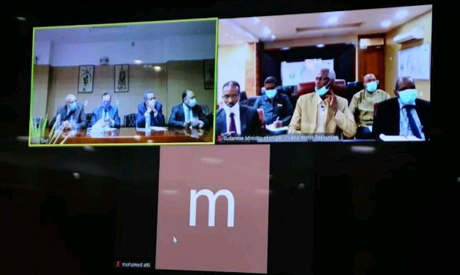
Sudan's Minister of Irrigation and Water Resources Yasir Mohamed takes part in a video meeting at the ministry in Khartoum on June 9, 2020, over the Grand Ethiopian Renaissance Dam. - Egypt's President Abdel Fattah al-Sisi strongly rebuked Ethiopia, accusing Addis Ababa of stalling negotiations over a mega-dam being built on the Nile and moving ahead with plans to start filling the reservoir before reaching a deal (Photo courtesy of the Sudanese irrigation ministry)
Egypt has called on Ethiopia to vow not to take any “unilateral action” with regards to the filling of its disputed Grand Ethiopian Renaissance Dam (GERD) until a tripartite agreement between Egypt, Ethiopia and Sudan is reached.
In an official statement on Wednesday, Egypt’s Ministry of Irrigation and Water Resources said it stressed on four conditions during a virtual meeting between the irrigation ministers of the three countries, including reiterating a call to Addis Ababa to declare it would take no “unilateral action” on filling the dam.
Cairo demanded a four-day timeframe, from 9 to 13 June, to reach an agreement on the filling and operation of the dam.
A second meeting, agreed upon by all parties, will be held on Wednesday in the attendance of observers, it said.
It stressed that the reference for discussions should be the Washington and World Bank-brokered document on the dam on 21 February. Egypt is the only country that initialed the document. Washington failed to secure the signatures of Ethiopia and Sudan.
Tuesday’s talks were the first between the three sides since February, when Ethiopia pulled out of the Washington meeting.
Sudan has held talks with Egypt and Ethiopia in the past weeks to bring all the parties back to the table following an escalating war of words between Cairo and Addis Ababa.
According to the statement, Egypt asked during Tuesday’s talks that observers who attended the meeting, including the US, European Union and South Africa, act as “facilitators.”
“It is difficult to describe the meeting as positive or as one that reached a substantial outcome, as it focused on procedural issues related to the schedule for meetings and the role and number of observers,” the Egyptian irrigation minister said.
Egypt said the talks on Tuesday reflected a willingness by Ethiopia to “reopen discussions on all issues” rather than stick to its plan to start filling the dam next month, including with regards to suggestions put forward by Addis Ababa during previous talks, as well as regarding figures and schedules discussed during the Washington meetings.
The Egyptian statement came one day after Sudanese Irrigation Minister Yasser Abbas described the talks as “positive and fruitful.”
Cairo had demanded ahead of the meeting for a timeframe for the technical talks with Ethiopia and Sudan on the dam, according to a statement by the Egyptian National Security Council chaired by Egyptian President Abdel-Fattah El-Sisi.
It said a timeframe for the talks was crucial so as to not allow talks from becoming “a new tool for stalling or evading the obligations of the Declaration of Principles of 2015.”
Ethiopia hopes the massive $4.8 billion megaproject on the Blue Nile, which has been under construction since 2011, will allow it to become Africa’s largest power exporter.
Egypt receives an annual release of 55.5 billion cubic metres from its High Aswan Dam, while it requires over 80 billion cubic metres to meet its needs. The country bridges the gap by water recycling and reuse.
Cairo fears the dam will diminish its water supply from the Nile, on which it relies for the vast majority of its fresh water.
The populous country currently has a water share of around 570 cubic metres per person annually, well below the water scarcity level of 1,000 cubic metres per person per year. The figure is expected to drop further to 500 cubic metres by 2025.
Short link: